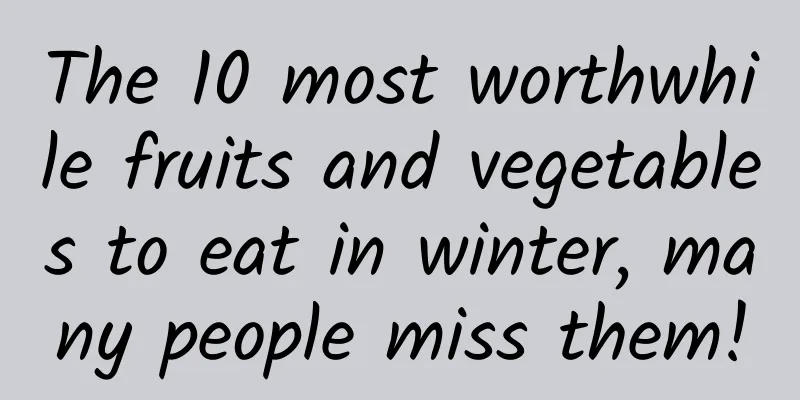The 10 most worthwhile fruits and vegetables to eat in winter, many people miss them!

|
Some foods can provide a lot of nutrition with just a small bite, while some foods, even if eaten in a large bowl, will only make you feel full and bloated, but you will get very little nutrition. This is due to the difference in the nutritional density of the food. "Nutrient density" refers to the concentration of important nutrients in a food on a per-calorie basis. High-nutrient-density foods are foods that are high in vitamins, minerals, dietary fiber, and phytochemicals or essential fatty acids, but should also contain relatively little fat, sugar, and energy. So, which vegetables and fruits have high nutritional density in winter? In today’s article, the author has compiled 10 kinds of fruits and vegetables that are high in nutritional density and suitable for consumption in winter. Don’t miss them. Copyrighted stock images, reprinting and using may cause copyright disputes Top 5 vegetables Recommendation basis: outstanding nutritional content, common and cheap. (Many vegetables are very nutritious, but some are not common or expensive, so they are not recommended this time, but not being selected does not mean they are bad.) No.1 Spinach The first thing I want to recommend is spinach. Spinach has the highest content of vitamin K among all foods. It also has high content of antioxidant nutrients such as beta-carotene and lutein, as well as folic acid. Vitamin K can promote calcium deposition in bones and strengthen bone hardness; beta-carotene and lutein can not only help the body remove free radicals, but also have a certain effect of protecting the cardiovascular system and are also very helpful for eye health. In addition, folic acid is also very friendly to the cardiovascular system. It should be noted that although spinach is high in nutrients, it also has a high oxalic acid content. Its astringent taste will affect the absorption of minerals such as calcium and iron. Therefore, it should be blanched in advance when cooking, which can remove most of the oxalic acid. In addition, fresh spinach should be selected for cooking, as unfresh spinach has a high nitrite content. No.2 Broccoli Broccoli is a cruciferous vegetable rich in isothiocyanates. In addition, it is also high in folic acid, containing 210μg of folic acid per 100g. Copyrighted stock images, reprinting and using may cause copyright disputes Isothiocyanates can inhibit cancers induced by a variety of carcinogens. Meta-analysis found that increasing the proportion of cruciferous vegetables in the diet is associated with a lower risk of gastric cancer, breast cancer, and lung cancer. The U.S. Cancer Prevention Guidelines list eating more cruciferous vegetables as one of the recommendations. In addition, folic acid is helpful in preventing cardiovascular disease and neural tube defects in the fetus. No.3 Shiitake Mushrooms Shiitake mushrooms are a member of the mushroom family and are rich in polysaccharides. In addition, shiitake mushrooms are one of the few plant foods with a relatively high vitamin D content, with each 100g of fresh shiitake mushrooms containing 1.6μg of vitamin D. Mushroom polysaccharides have the effects of immune regulation, anti-tumor, and regulating blood sugar and blood lipids. They are very friendly to people with low immunity, cancer patients, and friends with cardiovascular diseases. Vitamin D can promote calcium absorption. In addition, shiitake mushrooms are low in calories and are very suitable for friends who need to control their calorie intake. No.4 Carrot As the saying goes, "carrots are little ginseng." Although this statement is an exaggeration, carrots are indeed rich in nutrients. Carrots’ beta-carotene ranks among the highest among common vegetables. Beta-carotene not only has antioxidant and anti-inflammatory effects, but can also be converted into vitamin A in the body, which is essential for maintaining the integrity of epithelial cells and ensuring the health of the respiratory tract. In addition, beta-carotene itself can enhance the immune function of cells and reduce the occurrence of infectious diseases. Carrots are also good at cooking. They have bright colors, increase appetite, and go well with many vegetables. No.5 Rapeseed Rapeseed is a well-deserved popular vegetable. It is available all year round and suitable for all kinds of meals. It is low in calories and high in calcium. It contains 148 mg of calcium per 100 g, which is 1.4 times the same weight of milk. If it is black rapeseed, the calcium content is even higher, with 191 mg of calcium per 100 g. If you drink less milk, you can consider making rapeseed a regular ingredient in your diet. Seeing this, I wonder if you often eat these 5 kinds of vegetables? Next, let’s take a look at which fruits are on the list! Top 5 fruits Unlike nutrient-rich vegetables, the nutrition of fruits is relatively simple, mainly vitamin C, potassium, dietary fiber and some antioxidant phytochemicals. Recommendation basis: Good nutrition, seasonal, and relatively low in sugar. No.1 Kiwi Kiwi fruit is a common fruit rich in vitamin C , with 62 mg of VC per 100 g. Eating one and a half kiwis can meet the 100 mg daily requirement of an adult. In addition to vitamin C, the lutein and zeaxanthin content in kiwi fruit is relatively high among fruits. Although it is not as high as vegetables, it is a supplement for those who eat less dark vegetables. Copyrighted stock images, reprinting and using may cause copyright disputes In addition to helping iron absorption, vitamin C can also promote the synthesis of collagen, making the skin rosy and elastic. VC can also resist oxidation and help form antibodies to improve the body's immunity. No.2 Strawberry Strawberries are seasonal fruits in winter and are very low in calories, with only 32 kcal in 100 grams, making them especially suitable for those who want to control calories. In addition, although the vitamin C content of strawberries is not as high as that of kiwifruit, it is higher than that of tangerines and oranges. Eating six or seven large strawberries can meet the daily VC needs. Strawberries have the highest folic acid content among fruits, with 32μg of folic acid per 100g. In addition, strawberries also contain antioxidant ingredients such as anthocyanins and polyphenols , which have antioxidant and anti-inflammatory effects. The small seeds on the surface can also help gastrointestinal peristalsis, helping the body to "detoxify" in a two-pronged way. No.3 Grapefruit Grapefruit looks ordinary, its energy is not the lowest, and its vitamin C content is not very high. However, among seasonal fruits in winter, grapefruit has low sugar content and raises blood sugar slowly, so it is worth recommending. However, although grapefruit is good, you should also pay attention to controlling the amount of consumption. Especially for diabetics, it is best to eat no more than 3 grapefruit slices a day, in divided doses. No.4 Pear Pears are rich in dietary fiber. Every 100g of pears contains about 2.6g of dietary fiber, while Korla pears contain up to 6.2g, which is top-tier content among fruits. Copyrighted stock images, reprinting and using may cause copyright disputes Dietary fiber contributes to digestive health and bowel movements. In the latest dietary guidelines released by the World Health Organization in July, it is strongly recommended that adults should consume at least 25g of dietary fiber per day through natural foods. In addition, pears also contain fructose and sorbitol, which are helpful for intestinal peristalsis. It is a fruit worth trying for those who often suffer from constipation. However, for those with weak gastrointestinal function, it is recommended to eat less or choose varieties with less dietary fiber, such as snow pear and moon pear. No.5 Apple Although there are many kinds of fruits now, apple is one of the few fruits that we can eat from childhood to adulthood. Although apples do not contain high levels of vitamin C, they are rich in antioxidant polyphenols, chlorogenic acid, flavonoids and other phytochemicals, and their blood sugar-raising rate is not the fastest among fruits. In addition, they are affordable, so they are worth recommending in winter. Apples are rich in pectin. If you don’t like eating cold fruits in the winter, hot, plump baked apples or apples cooked with rock sugar are also very delicious. There are many more nutritious vegetables and fruits, which cannot be listed here one by one. "Nutrient density" is a valuable concept, which can be used as a concept when choosing food, but if you want to eat healthily, you still need to pay attention to food diversification, eat more dark-colored fruits and vegetables, and ensure that there are vegetables at every meal (300-500g per day) and fruits every day (200-350g per day). Only when the food is diverse can the nutrition complement each other. References [1] Yang Yuexin. Chinese Food Composition Table Standard Edition, 6th Edition, Volume 1[M]. Beijing: Peking University Medical Press, 2018. [2] Yang Yuexin and Ge Keyou. Encyclopedia of Chinese Nutrition Science, 2nd edition (Volume 1) [M]. Beijing: People's Medical Publishing House, 2019. [3] Chinese Nutrition Society. Dietary Reference Intakes of Nutrients for Chinese Residents (2023 Edition)[M]. Beijing: People's Medical Publishing House, 2023. [4] Chinese Nutrition Society. Dietary Reference Intakes of Nutrients for Chinese Residents (2013 Edition) [M]. Beijing: Science Press, 2014. [5]Carbohydrate intake for adults and children: WHO guideline. Geneva: World Health Organization; 2023. License: CC BY-NC-SA 3.0 IGO. [6]USDA, Food Data Central, Mushroom, maitake, https://fdc.nal.usda.gov/fdc-app.html#/food-details/2003602/nutrients [7] Japanese food composition table. http://www.mext.go.jp/a_menu/syokuhinseibun/1365297.htm Planning and production Author: Li Chun, a registered dietitian in China. Reviewer: Ruan Guangfeng, deputy director of the China Science and Technology Information Exchange Center for Food and Health. Planner: Zhong Yanping. Editor: Yinuo. Proofread by Xu Lai and Lin Lin |
<<: Do we have to be better ourselves? Perfectionism is not "perfect"...
Recommend
my country's first million-ton offshore carbon dioxide storage project put into operation
Reporters learned from China National Offshore Oi...
Foreign practical information! 6 methods to help you design an excellent APP
Many people are full of praise for Parable's ...
A new variant of the novel coronavirus has emerged? 637 cases have been found! Will it be impossible to eliminate the virus? Wu Zunyou responded
From 0:00 to 24:00 on April 1, 2,129 new confirme...
How much does it cost to customize a mechanical equipment mini program in Chuxiong?
How much is the quotation for customized Chuxiong...
WebViewJavascriptBridge-Bridge between Obj-C and JavaScript
[[138163]] WebViewJavascriptBridge is an iOS/OSX ...
Dragon Ball Collection Collector's Edition
For the die-hard fans of Dragon Ball, it is not e...
Lao Duan talks about OTT: Is there a piece of meat in cable live streaming?
Integrating cable live broadcast at the terminal ...
Asu Men's Physical Fitness Improvement Course, 10 lessons in the Sexual Ability Max Training Camp will help you improve your combat effectiveness
Asu Men's Physical Fitness Improvement Course...
Is Megalodon an imaginary monster? Learn more about the mysterious Megalodon!
Megalodon is not a fictional monster, it really e...
So the question is: Why does Google release a high-priced flagship Nexus?
I believe that many Google fans, like me, were ex...
Is eating 200 of them equivalent to taking a chest X-ray? Can eating this radioactive fruit actually make people happy?
Expert in this article: Wang Silu, National Senio...
How to plan a live e-commerce event
Live streaming began to explode in 2015, sparking...
How much does it cost to develop a makeup mini app in Huai'an?
Is it easy to develop a Huai'an makeup mini p...
Strategy Analytics: Global 5G smartphone shipments are expected to reach 199 million in 2020
Strategy Analytics' latest research report po...
Tesla, BYD and Xiaopeng, recommendations for their long-range new energy vehicles: Which one is right for you?
After my country announced a reduction in subsidi...









